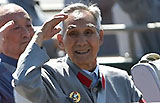Four-man art show demonstrates the power of friendship
By Chang Jun (China Daily USA) Updated: 2015-10-20 06:03A new exhibit of works by four diverse artists at the San Francisco International Art Center borrows its name from Rumi’s poem, and offers images and connections that are just as wonderful and mysterious as the question posed. Aside from creating dazzling work, all four artists have another thing in common —a strong affinity to Chinese tradition.

Artists Ming Ren, Fred Martin, David Frazer and Jeremy Morgan are all established contemporary painters and recipients of multiple national and international awards.
Xiao Xiayong, cultural counselor at the Chinese consulate general in San Francisco, said the most fantastic thing about the exhibition, to him, was to see how Ming Ren, who was originally from China, could develop his artistic style in the US by combining traditional Chinese painting styles with modern Western expressionism. And how the other three painters, all professors educated in the West, were attracted by Chinese culture and could express it in their work.
Just last year, Fred Martin, in his late 80s, traveled with his 93-year-old wife to China to keep himself abreast of the latest developments and trends in China’s art world. His work explores the complexities of natural geometric and fluid forms.
A distinguished teacher and academician, Martin has served as the academic dean and professor of drawing and painting at the San Francisco Art Institute besides serving as director of exhibitions at the San Francisco Art Institute.
David Frazer has taught at the Rhode Island School of Design (RISD) since 1978 and served as chairman of the painting department there. His paintings tend to be muted in color, but still active in composition and form. Fazer has exhibited nationally and internationally in Italy, South Korea, the Netherlands and China. He has travelled extensively in East Asia, immersing himself in the traditions of Zen Buddhism and Chinese philosophy.
Jeremy Morgan keeps exploring ways to fuse his abstract approach with Chinese Shan Shui (landscape) style. Since the 1980s, he has made roughly 20 trips to China which have had a profound influence on his work. His paintings echo the blurring and transparent edges of traditional Shan Shui, or “mountains and rivers” paintings with acrylics. Educated at the Royal Academy in the UK, Morgan was also influenced by the American landscape painters of the 17th through 19th century.
Ming Ren, a lecturer at RISD and consultant on China at both the San Francisco Art Institute and the California College of the Arts, demonstrates his deep roots in Chinese ink and brush painting through his early works.
In his more recent work, however, Ren achieves a geologic sensibility through the pouring of his paints, twisting of the wet rice papers and the chance movement and absorption of colors in them.
"Obviously, there is a strong influence from the Western abstract styles," said Wu Junkai, president of the art center.
Cultural interaction does not simply mean exchanging artistic techniques, it should be a deep understanding of people different from our own and inspire a new way of looking at the world, said counselor Xiao.
The result seems obvious in this exhibition, and answers poet Rumi’s question about what shall we call this new sort of "house", where, through mutual admiration, people from around the world, regardless of their background or ethnicity, are able to communicate in one language — it’s called friendship.
Contact the writer at junechang@chinadailyusa.com





